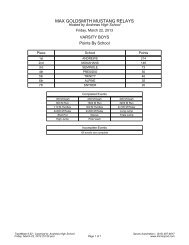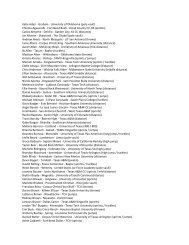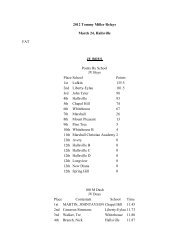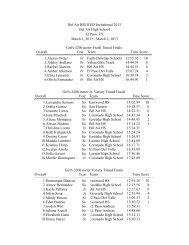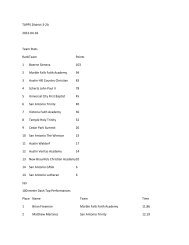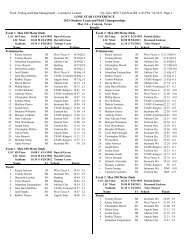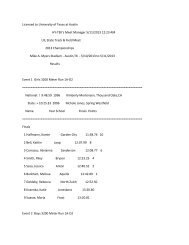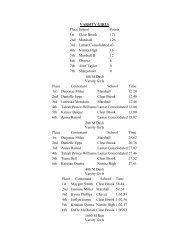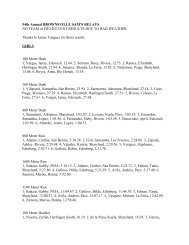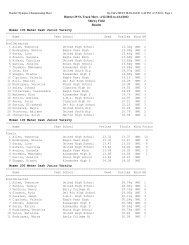1. PAGES 1-35 - Texas Track & Field Coaches Association
1. PAGES 1-35 - Texas Track & Field Coaches Association
1. PAGES 1-35 - Texas Track & Field Coaches Association
Create successful ePaper yourself
Turn your PDF publications into a flip-book with our unique Google optimized e-Paper software.
a pole relative to their top<br />
speed. Much of this difference<br />
is likely due to pole size more<br />
so than to carry efficiency but<br />
that was not tested.<br />
These willing athletes exhibited<br />
a wide range of abilities. All<br />
of them did have experience<br />
with none being raw beginners<br />
(no experience). Those with<br />
more experience and with<br />
greater performances (higher<br />
vaults to their credit) tended to<br />
run faster and had a more even<br />
acceleration curve. An example<br />
is provided in Tables 3 and 4<br />
with their corresponding<br />
graphs. Comparing these two<br />
athletes, one was a high school<br />
intermediate and the other a<br />
skilled high school athlete (in<br />
fact, one of the top high school<br />
athletes attending the clinic).<br />
This may suggest that it is a skill<br />
to develop an approach that<br />
can smoothly and effectively<br />
bring an athlete to top speed, or<br />
put another way, bring an athlete<br />
to useable top speed.<br />
Observing all the data, it seems<br />
that just running from further<br />
back is not likely the key factor<br />
in bringing out the athlete’s<br />
very best.<br />
TO SUM UP THE STUDY<br />
OF THIS GROUP:<br />
These athletes were running<br />
at 90 percent of their top speed<br />
less than 60 feet into their trial<br />
run whether they carried a pole<br />
or did not carry a pole.<br />
On average, the remaining 10<br />
percent of their top speed required a distance of between 50<br />
and 60 feet, or roughly half the distance required to accelerate<br />
to top speed, again whether carrying a pole or not. The boys<br />
tended to need a little more distance to hit top speed when carrying<br />
a pole whereas the girls tended to need a little less distance.<br />
Carrying a pole while running slowed these runners about<br />
five percent.<br />
An unmeasured observation was that the faster and more<br />
experienced athlete took longer (distance run) to reach top<br />
speed and tended to have a more regular acceleration curve<br />
than the less-experienced and slower athlete.<br />
I think these observations are worthy of consideration for the<br />
coaching of all jumping events. Of special coaching note is that<br />
if an athlete needs more technical preparation in jumping<br />
mechanics, taking more trials from an approach of six to 10<br />
steps (three to five lefts) makes good sense. The athlete will, in<br />
all likelihood, be able to take more attempts, concentrate<br />
jumping technique, and still function near top speed. The<br />
process of achieving top speed in a controlled and “smooth or<br />
regular” manner also appears to be a skill and therefore needs<br />
to be practiced as well.<br />
ADDENDUM<br />
The Brower timing system was also used in the Friday night<br />
elite men’s and women’s competitions. In congruence with<br />
existing research model on runway velocity just prior to the<br />
take off, photo gates were set up to time the last five meters<br />
prior to the take off. Results of each attempt of these elite athletes<br />
was recorded and shown to the audience on the display<br />
units provided. My sincere thanks to Mark Brower and the<br />
Brower Timing System staff for their support of the Reno Pole<br />
Vault Summit and this project.<br />
AUGUST 2011 techniques 15



